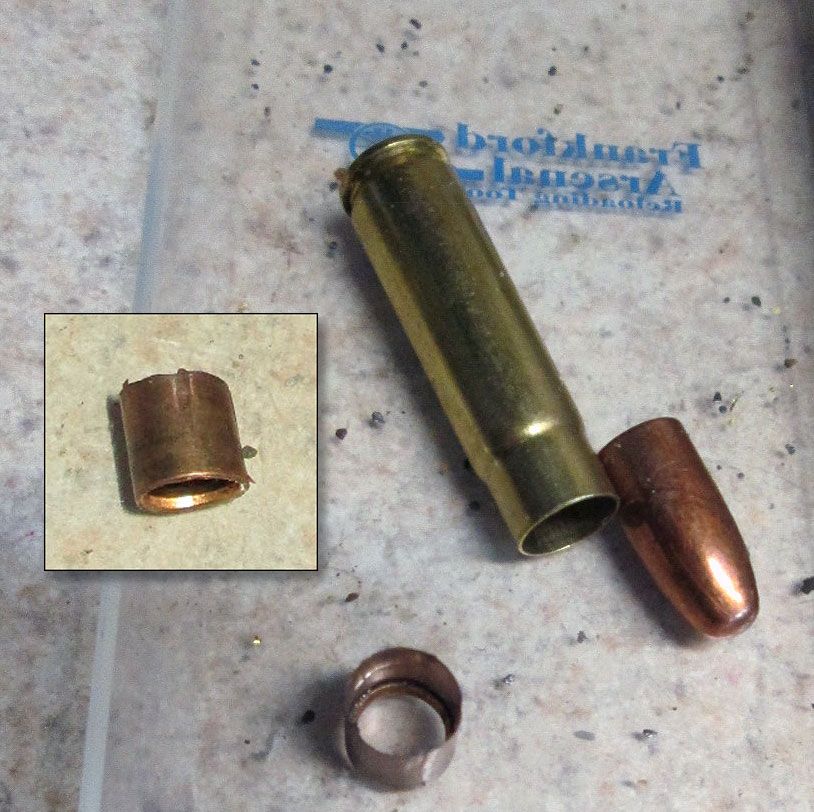More 300 Blackout Bullet Trouble
A few months ago, I wrote an article about the accuracy problems I experienced when substituting a 110gr Hornady SP bullet for a Hornady 110gr V-Max bullet in .300 AAC Blackout. Recently, I received an email from reader "Motorcycle_Dan from Ohio" describing his more troubling experience with the same caliber and a different 110gr bullet:
I read your 300AAC Blackout bullet substitution article. I had a similar experience, but mine had different and potentially more dangerous results.
I picked up some 110 gr JRN (M1 Carbine bulk bullets) because those were the only .308 bullets I could find, and some IMR 4227 powder.
The data I found for 110gr bullets was for the Hornady 110gr Vmax bullets, which had a specified cartridge overall length of 2.040". At that length, the 110gr JRN bullets would barely have been clamped in the case mouth. Instead of trying to seat them close to the rifling, I seated them about 2/3 of the way into the neck (which puts about the same amount of bullet into the case as a "normal" M1 Carbine round).
I loaded 5 rounds with 17.5 grs of IMR-4227 (which is right around the minimum charge recommended for the 110gr V-Max bullets) shot them, and found that they were too weak to cycle the rifle. I made 5 more at 18.5 grs (well below the maximum of 19.5 grs). These rounds cycled the rifle. However, while the first three rounds were normal, the fourth round sounded different stronger - and the shot flew way off call. I was loading two rounds at a time, and the bolt locked open after the last round as it should.
The case showed signs of high pressure, but not overpressure. It had a flat primer that looked like the result of a hot 600 yard 77gr .223 load. Since the shot sounded funny, I opened the action, removed the BCG, and verified the bore was clear. I reassembled the rifle, loaded 2 more, and the first round jammed on feed. I extracted and examined the round, and checked the bore (which still looked clear). I tried it again with the same result. Next I hand-placed a round in the chamber then dropped the bolt on it, and the rifle would not go into battery. I took it apart, ran a bore snake through it (I didn't have rod at the range), tried it again and had the same result. . I decided to move on to other projects and planned to figure it out at home.
What I found was part of the projectile's jacket - from where it contacted the rifling at the ogive back to the base - was still stuck in the leade area of the chamber! The jacket parted right where it contacted the rifling (See Figure-1), sending the nose of the jacket and the lead core of the bullet down the barrel!

My diagnosis is this: The bullet starts moving early as pressure builds. It moves along the leade area until it contacts the rifling, where it does not have enough pressure to continue, The bullet stops and a dynamic pressure wave reverberates back into the case causing a rapid burn rate of the remaining powder (like an expansion chamber on a 2-stroke dirt bike). This reversion spike causes pressure to escalate to the point where it causes the jacket to rupture, sending the core and nose of the jacket down the bore.
But I Use Those Bullets All the Time!
Before anybody dashes off an angry email telling me that they've loaded those same bullets to much higher velocities in a .30-06,
.308, etc., let me say that it's not just a higher-than-normal velocity that can cause a jacket rupture like this. The powder
burn rate, the amount of bullet jump, the angle of the throat where the rifling starts, and a bunch of other factors can all
affect the way a round behaves. Just because you've done it, doesn't mean that it will work everywhere (or continue to work for you).
In fact, I have a hundred or so .300 Savage rounds loaded up with these same bullets that I'm suddenly thinking about pulling.
Sometimes, there's a very good reason why you can't find data for a particular bullet/caliber combination.
One more thing…
Motorcycle_Dan's account made me think of a short video I show in my Home Firearms Safety classes when discussing squib loads:
A couple of chuckleheads are shooting an AR-15 at a range. One fellow pulls the trigger, gets a "click" instead of a "boom",
cycles the bolt, fails to inspect the ejected case, then proceeds to bang furtively on the forward assist, and chamber round-after-round
until he finally shoves the squibbed bullet far enough down the barrel to get the rifle to go into battery.
Predictably, when he pulls the trigger, the rifle explodes, and the shooter (unhurt and dancing around) launches into a brief but very creative profanity-laced tirade. It may be common sense, but any time you experience a malfunction or unusual occurrence while shooting at the range - whether it's with handloads or factory ammo - you should stop, field strip, and investigate. The temptation to tap/rack/bang may be strong, especially when others are watching, but if it's not a life or death situation (or if you are not purposely practicing malfunction drills) the right thing to do is to get to the root cause of the malfunction before proceeding.
Kudos to Motorcycle_Dan for having the presence of mind to do the right thing, and not make a bad situation worse.